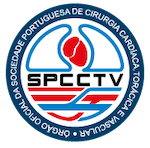CORRECTION OF ADULT-TYPE VSD CAUSING AORTIC VALVE ENDOCARDITIS THROUGH AORTOTOMY
DOI:
https://doi.org/10.48729/pjctvs.153Abstract
Ventricular septal defects are the most common congenital abnormality diagnosed in children but account for only 10 percent of congenital heart defects in adults. Although many defects close spontaneously before adulthood, many others persist, predisposing to endocarditis, and other complications. Herein, we report a case of a known, asymptomatic, perimembranous ventricular septal defects that has complicated at 53 years of age with the need for surgery due to native aortic valve endocarditis and concomitant severe aortic regurgitation. We opted to surgically repair the ventricular septal defects with a pericardial patch through the necessary aortotomy used for aortic valve replacement (Figure 1 and 2). The surgery was straightforward. Postoperative course was only marked by the need of a permanent pacemaker implantation due to a sick sinus syndrome, which was diagnosed before the surgery. Thus, we emphasize the role of surgery in repairing ventricular septal defects and the importance of choosing the appropriate approach, especially when concomitant heart lesions are present.
Downloads
References
Rojas CA, Jaimes C, Abbara S. Ventricular septal defects: embryology and imaging findings. J Thoracic Imaging. 2013 Mar;28 (2): W28-34
Gabriels C, De Backer J, Pasquet A, et al. Long-Term Outcome of Patients with Perimembranous Ventricular Septal Defect: Results from the Belgian Registry on Adult Congenital Heart Disease. Cardiology 2017; 136:147–155.
Prasad S. Ventricular Septal Defect. In: Diagnosis and Management of Adult Congenital Heart Disease, Gatzoulis MA WG, Daubeney PEF (Eds), Churchill Livingstone, Philadelphia 2003. p.171
Ammash NM and Warnes CA. Ventricular septal defects in adults. Ann Intern Med 2001; 135:812.
Baumgartner H, Bonhoeffer P, De Groot NM, et al; (ESC) TFotMoG-uCHDotESoC, (AEPC) AfEPC, (CPG) ECfPG: ESC guidelines for the management of grownup congenital heart disease (new version 2010). Eur Heart J 2010;31:2915–2957.
Mongeon FP, Burkhart HM, Ammash NM, et al. Indications and outcomes of surgical closure of ventricular septal defect in adults. JACC Cardiovasc Interv 2010; 3:290.
Tweddell JS, Pelech AN, Frommelt PC. Ventricular septal defect and aortic valve regurgitation: pathophysiology and indications for surgery. Semin Thorac Cardiovasc Surg Pediatr Card Surg Annu 2006; :147.
Kostolny M, Schreiber C, von Arnim V, et al. Timing of repair in ventricular septal defect with aortic insufficiency. Thorac Cardiovasc Surg 2006; 54:512.
Hofmeyr L, Pohlner P, Radford DJ. Long-term complications following surgical patch closure of multiple muscular ventricular septal defects. Congenit Heart Dis 2013; 8:541.






